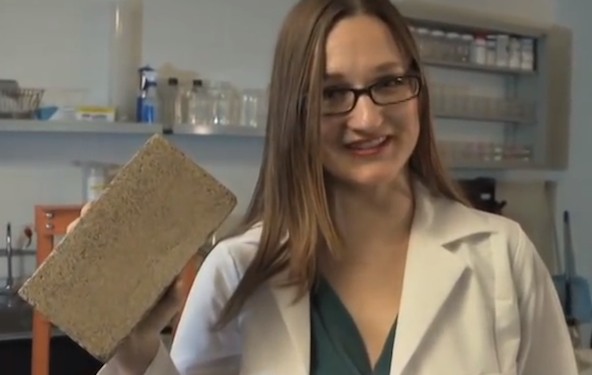
BioMASON founder and CEO Ginger Krieg Dosier talks about the technology behind brick biocementation. Credit: YouTube.
Green buildings may soon get a lot greener.
A young North Carolina company, bioMASON, is making strides to soon offer biologically manufactured bricks for commercial sale. Inspired by the biomineralization of calcium carbonate by coral, their simple, economical, and environmentally friendly process uses bacteria to cement together sand particles.
The bacteria, Sporosarcina pasteurii, are not picky. They require only the addition of nitrogen and calcium sources to produce calcium carbonate, cementing together sand to “grow” a brick at room temperature in less than a week.
According to bioMASON’s website, “Traditional materials contain a high-embodied energy, and rely heavily on limited natural resources.” By harnessing the work of microorganisms, bioMASON’s manufacturing process bypasses the need for high-temperature brick firing, eliminating hefty consumption of fossil fuels and corresponding release of carbon dioxide into the atmosphere. In addition, the process can be adapted to utilize industrial waste to provide nitrogen to the bacteria, eliminating other forms of pollution as well.
bioMASON recently won first place (i.e., cash prizes!) in two innovation contests, the Cradle to Cradle Innovation Challenge and the Dutch Postcode Green Challenge. According to the Dutch Postcode Green Challenge website, bioMASON founder and CEO Ginger Krieg Dosier had this to say: “With the prize money we will be able to achieve significant results faster and launch our sustainable bricks on a large scale. This is a huge encouragement.”
bioMASON has also partnered with the Biomanufacturing Training and Education Center (BTEC) at North Carolina State University to further product development. Although “the bricks compare favorably with traditional fired clay ones,” according to BTEC’s website, bioMASON will next work on developing low cost production techniques to move their bricks closer to the market.
Watch Dosier talk about the technology in the two-minute video above.
